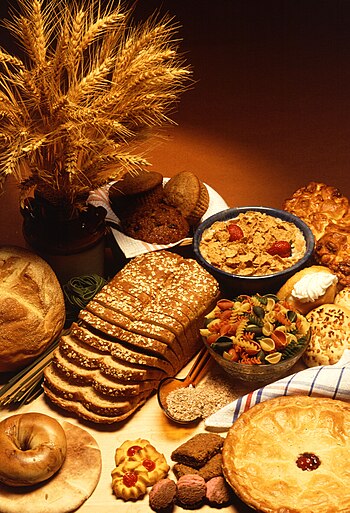Shop the Perimeters
| Fruits & vegetables are commonly found around the perimeter of the grocery store. (Photo credit: Wikipedia) |
Shop for Color
As you push your cart along the outer walls of the store, look for the bright and vibrant-color foods. As we've all learned in our nutrition classes, foods with rich, bright, or dark colors generally have more nutrients than those with a pale color. For instance, strawberries and eggplants have a higher nutrient-density than potatoes or onions. Even though potatoes and onions are perfectly fine and offer nutrition, to get the most bang out of your dieting buck, go for the bright colors. You can apply this to proteins in many instances, as well. A deep red salmon fillet is likely going to be more nutrient-dense than a salmon fillet that has a light color (it's also more likely to be naturally raised; farm-fed fish are often artificially colored with bright pink dye). Dark red meat (such as bison) is usually more likely to be grass-fed, and therefore more nutritious than grain-fed animals, whose meat is a lighter pink. (Remember - when shopping for meat, it is ALWAYS best to choose organic, and grass-fed if at all possible.)
Avoid Sugar by Any Name
You would be surprised at all the places sugar can hide in a grocery store. It is practically around every corner. Since sugar will stealthily rob you of your weight loss goals, it is important to turn into a detective in order to avoid it. Just for reference, here is a laundry list of aliases for sugar.
Agave nectar
Barley malt syrup
Brown sugar
Cane sugar
Corn sweetener
Corn syrup, or corn syrup solids
Dehydrated cane juice
Dextrin
Dextrose
Fructose
Fruit juice concentrate
Glucose
High-fructose corn syrup
Honey
Invert sugar
Lactose
Maltodextrin
Malt syrup
Maltose
Maple syrup
Molasses
Powdered sugar
Raw sugar
Rice syrup
Saccharose
Sorghum or sorghum syrup
Sucrose
Syrup
Treacle
Turbinado sugar
Xylose
Of course, not all sugar is created equal. Raw sugar may be a better choice than refined sugar, and the less-refined/processed, the better. However, when it comes to weight loss, your body isn't going to know the difference. It's going to want to turn that sugar into fat. Learn your sugars and learn what levels are tolerable for your diet. Be aware also that most processed foods that are labeled “low fat” have added sugar to adjust the taste! Here again, you need to know what is better for you and know your tolerable limits. Labels are your friend – get used to reading them.
| Choose whole grains when possible. (Photo credit: Wikipedia) |
One of the easiest tips to remember when buying bread, pasta, flour, and any type of baking ingredients is to go for whole grains rather than refined grains. Eating whole grains adds much-needed fiber and nutrients to your healthy diet. Fiber helps speed digestion and metabolism both. Refined grains have all that goodness cleaned right out of them during the refining process. Eating whole wheat pastas and breads, and baking with whole grain products may take some getting used to, but you can ease into it by using half refined and half whole grain to get started. It won't be long before you prefer the firmer texture and nuttier flavor of your favorite muffin recipe made with whole grains.
You don't have to carry a big list of foods allowed on a special diet along with you to the grocery store. You just have to shop smarter with these simple rules. It's easier to eat healthy when you have simple tricks to use when you're in the grocery store, and make a habit of following them. If you consistently fill your cart with foods from the perimeters, brightly colored foods, foods without added sugar, and whole grains, without much effort you are already well on your way to eating a diet that will help you lose weight now and keep it off for a lifetime!



No comments:
Post a Comment
We welcome comments and suggestions!